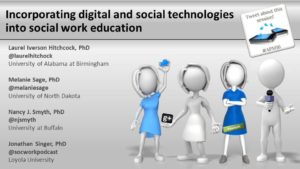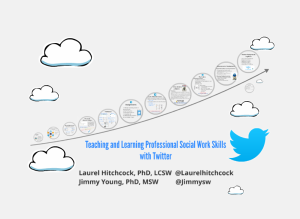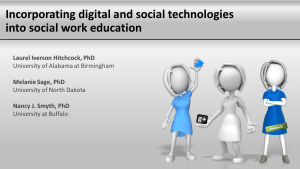The Shared Case Study: An online activity for Interprofessional Teamwork
Natalie Curry, LCSW is a Clinical Instructor at Missouri State University’s (MSU) School of Social Work. She has been on the faculty with MSU for two years and prior to that was an adjunct instructor for MSU, Drury University, and Washington University in St. Louis. Prior to entering academia, her practice background includes working with individuals who were homeless in various capacities, inpatient psychiatric care, and behavioral health consulting in primary care. In this post, she writes about an online, interprofessional learning activity that she helped to develop and implement with colleagues at MSU You can follow Natalie on Twitter at @natalielcsw.
Last fall, there was considerable interest around interprofessional education in the College of Health and Human Services (CHHS) at Missouri State University (MSU), where I work. My colleagues and I believed that we were doing well at talking with our students about how much collaboration they would do in their careers with other healthcare professionals. But we wanted to go further and figure out ways to provide the students real opportunities for interprofessional practice in their educational programs. That was part of the motivation for bringing together faculty from all 11 disciplines (such as social work, nursing, medicine and others) within CHHS, in addition to the University of Missouri-Kansas City School of Pharmacy which was already in partnership with MSU. The other part of motivation was a growing recognition that interprofessional activities were no longer just encouraged in many of our disciplines’ accreditation standards; they were required.
Starting in Fall 2015, our committee to begin developing interprofessional educational activities for our students. We met monthly and eventually decided that it was not feasible to develop one activity, project, or experience that all students from CHHS could do together and still be meaningful. We decided on four “menu items” that each discipline could choose to participate in, depending on the needs of their students. We wanted to have a mix of interprofessional activities, ranging from one-day experiences to projects that could be implemented over the course of a semester.
Review of Teaching & Learning in Social Work Blog Posts for 2016
 The end of a year is a natural time for reflection, and this year I offer a review of all the posts that appeared on Teaching & Learning in Social Work Education during 2016. My goal for this blog is to write or publish at least two posts a month, which happened more months than not. I also recruited other social work educators to write about their own experiences in the classroom or with scholarship, and also write about about all of my presentations, either at conferences or as a part of a workshop. This year, I published a total of 25 blog posts, representing work with numerous collaborators and good colleagues. Below is a list of this year’s post grouped around the topics of assignments, projects, guest educator posts, and conference presentations.
The end of a year is a natural time for reflection, and this year I offer a review of all the posts that appeared on Teaching & Learning in Social Work Education during 2016. My goal for this blog is to write or publish at least two posts a month, which happened more months than not. I also recruited other social work educators to write about their own experiences in the classroom or with scholarship, and also write about about all of my presentations, either at conferences or as a part of a workshop. This year, I published a total of 25 blog posts, representing work with numerous collaborators and good colleagues. Below is a list of this year’s post grouped around the topics of assignments, projects, guest educator posts, and conference presentations.
Assignments: These blog posts provide information, how-to tips, and ideas about different types of technology-based assignments for the social work classroom:
– Job Shadowing on Twitter with Joy Jones on 1/8/16
– Tweet, Tweet!: Using Live Twitter Chats in Social Work on Education with Dr. Jimmy Young on 1/29/16
– Using #MacroSW in the Classroom with the @OfficialMacroSW Partners on 3/14/16
– Using Pinterest in Undergraduate Social Work Education – #BPDTX16 with Dr. Lisa Baker on 3/31/16
– Revised Technology-Based Learning Task List for Social Work Education with Drs. Melanie Sage and Nancy J. Smyth on 6/13/16
#APM16 Day 3 -Incorporating Digital & Social Technologies into Social Work Education
 This is Day 2 of CSWE’s 2016 Annual Program Meeting, and it will be a busy day. One of the highlights for me will be presenting as part of panel of other #swtech educators – Drs. Melanie Sage (University of North Dakota), Jonathan B. Singer (Loyola University & The Social Work Podcast) and Nancy J. Smyth (University at Buffalo, SUNY). Our panel discussion is about how to how to infuse social and digital technologies into social work courses and curricula. Topics will focus on digital literacy, using theory to inform the integration of technology into online courses, and creating assignments and learning activities for social work courses that incorporate technology.
This is Day 2 of CSWE’s 2016 Annual Program Meeting, and it will be a busy day. One of the highlights for me will be presenting as part of panel of other #swtech educators – Drs. Melanie Sage (University of North Dakota), Jonathan B. Singer (Loyola University & The Social Work Podcast) and Nancy J. Smyth (University at Buffalo, SUNY). Our panel discussion is about how to how to infuse social and digital technologies into social work courses and curricula. Topics will focus on digital literacy, using theory to inform the integration of technology into online courses, and creating assignments and learning activities for social work courses that incorporate technology.
Revised Technology-Based Learning Task List for Social Work Education
 Back in April 2016, Melanie Sage, Nancy Smyth, and I first shared a list of technology-based learning activities that we developed based on Council on Social Work Education’s Social Work Competencies from the 2015 Educational Policy and Accreditation Standards (EPAS). The purpose of this list is to help social educators infuse learning about and with technology across the social work curriculum. We have updated our list to keep with the evolving understanding of how to apply CSWE’s 2015 EPAS. Here are the main features of the list:
Back in April 2016, Melanie Sage, Nancy Smyth, and I first shared a list of technology-based learning activities that we developed based on Council on Social Work Education’s Social Work Competencies from the 2015 Educational Policy and Accreditation Standards (EPAS). The purpose of this list is to help social educators infuse learning about and with technology across the social work curriculum. We have updated our list to keep with the evolving understanding of how to apply CSWE’s 2015 EPAS. Here are the main features of the list:
– Over 100 different example assignments and learning tasks with brief directions that can be incorporated into social work courses across the curriculum.
– Assignments are designed to encourage students to share their work with a class/seminar or practicum field instructor.
– For assessment purposes, each assignment and learning task is grouped by competency and component behaviors, and then labelled with the relevant competency dimensions using the following key: K = Knowledge; V=Values; S= Skills; and CA = Cognitive and Affective Processes.
You can access the new version of the list here: Technology-Based Learning Task List for Social Work Education (Version 1.1 – 6/13/16)
#SWDE2016 Teaching & Learning Professional Social Work Skills w/ Twitter
 On Day Two of the Social Work Distance Education Conference, I will be presenting a workshop about the work Jimmy Young and I have done with Twitter in the classroom. If you are at the conference today, please join me in the B& O Room at 3:45 PM for the workshop. Our work focuses on the growing awareness that Twitter, a micro-blogging social media platform, can be a valuable tool in social work education to help students develop and practice social work competencies. This workshop will inform participants about the development, implementation and assessment of different assignments using Twitter for teaching social welfare policy and macro social work practice. Sample assignments, practical tips and a demonstration of Twitter will be provided to participants. The learning objectives for the workshop include:
On Day Two of the Social Work Distance Education Conference, I will be presenting a workshop about the work Jimmy Young and I have done with Twitter in the classroom. If you are at the conference today, please join me in the B& O Room at 3:45 PM for the workshop. Our work focuses on the growing awareness that Twitter, a micro-blogging social media platform, can be a valuable tool in social work education to help students develop and practice social work competencies. This workshop will inform participants about the development, implementation and assessment of different assignments using Twitter for teaching social welfare policy and macro social work practice. Sample assignments, practical tips and a demonstration of Twitter will be provided to participants. The learning objectives for the workshop include:
1.Understand how the social media platform Twitter can be incorporated into assignments for social work courses to advance learning of the profession’s competencies.
2. Demonstrate how social work educators can assess attainment of competency among students using a social media assignment paired with a rubric for evaluation of the assignment’s learning outcomes.
3. Appreciate the role of professional collaboration in the development, implementation and assessment of social media-based assignments.
Here are some of the resources from the workshop:
Prezi Slides – Teaching & Learning Professional Social Work Skills w/ Twitter Workshop
How to Participate in a Live Twitter Chat – Tips for Social Workers
#SWDE2016 Incorporating Digital & Social Technologies into Social Work Education
 Today is the Day 1 of the Second Annual Social Work Distance Education Conference, and I am lucky enough to be presenting with Drs. Melanie Sage (University of North Dakota) and Nancy J. Smyth (University of Buffalo, SUNY) about how to incorporate digital and social technologies into social work education. Our workshop will inform participants about the mechanics as well as the advantages and disadvantages of incorporating digital and social technologies assignments into social work courses. Topics to be covered include the importance of digital literacy and how to use theory to inform the integration of technology into their online courses. Participants will learn about example assignments and learning activities for social work courses that incorporating digital and social media such as microblogging, designing infographics, and creating a video. By the end of the workshop, participants will:
Today is the Day 1 of the Second Annual Social Work Distance Education Conference, and I am lucky enough to be presenting with Drs. Melanie Sage (University of North Dakota) and Nancy J. Smyth (University of Buffalo, SUNY) about how to incorporate digital and social technologies into social work education. Our workshop will inform participants about the mechanics as well as the advantages and disadvantages of incorporating digital and social technologies assignments into social work courses. Topics to be covered include the importance of digital literacy and how to use theory to inform the integration of technology into their online courses. Participants will learn about example assignments and learning activities for social work courses that incorporating digital and social media such as microblogging, designing infographics, and creating a video. By the end of the workshop, participants will:
1. Understand the importance of digital literacy in 21st century social work practice.
2. Demonstrate how digital and social technologies can be incorporated into assignments for social work courses.
3. Appreciate the role of theory to support the development and implementation of technology-based assignments.
Here is a link to the slides from the workshop: https://www.slideshare.net/secret/8jgUUNwPcTPt46.
We also shared the following handout: Technology-Based Learning Task List for Social Work Education.



